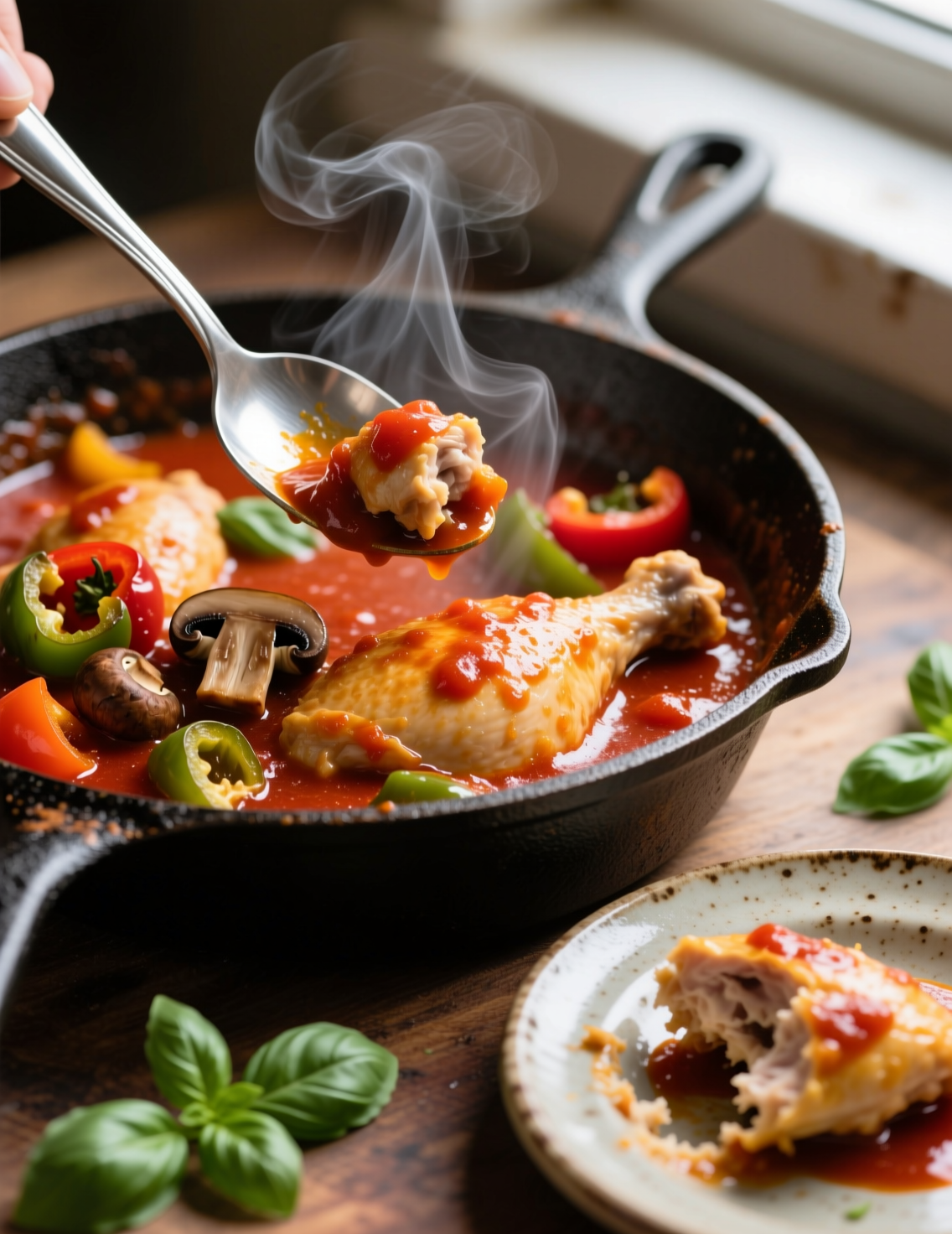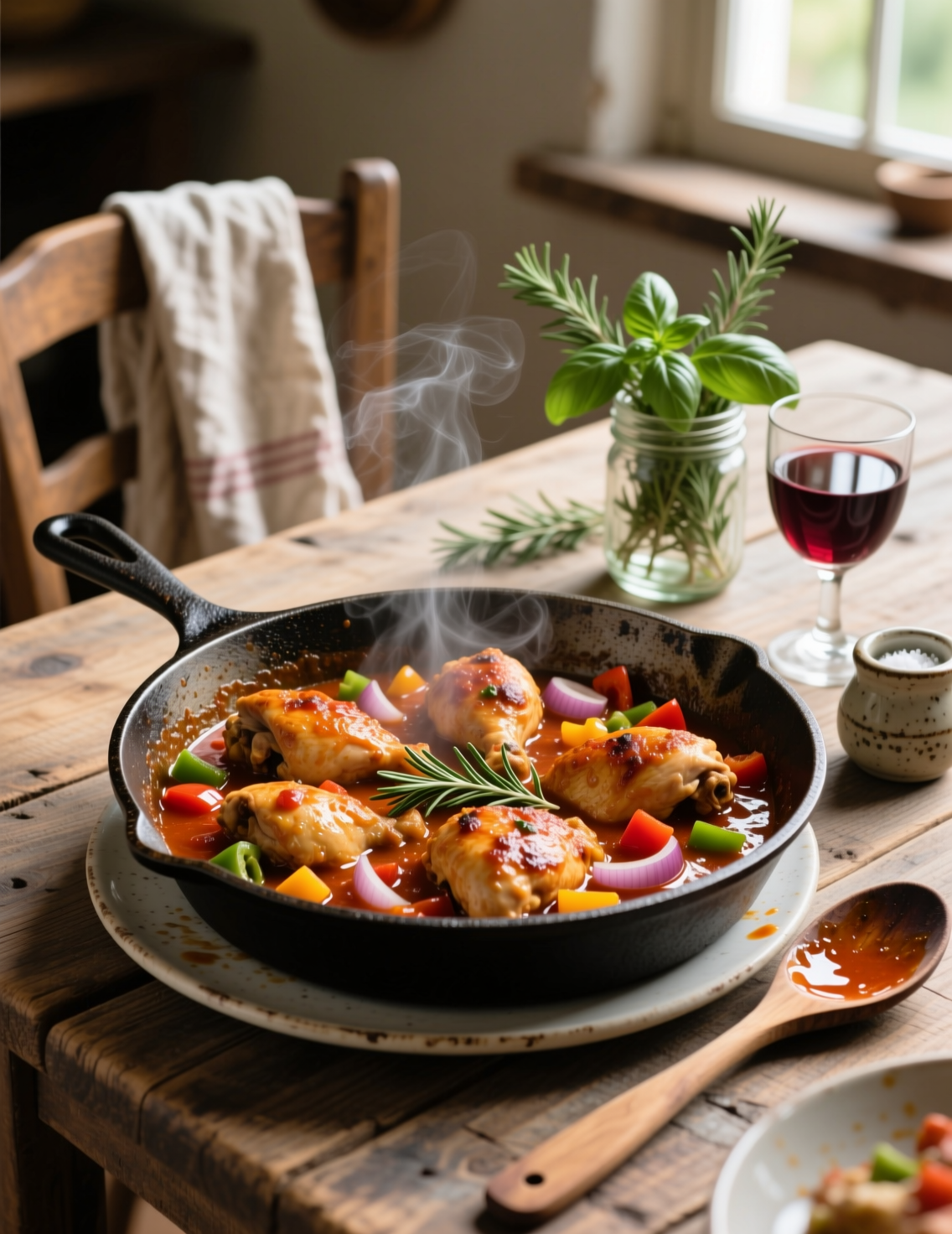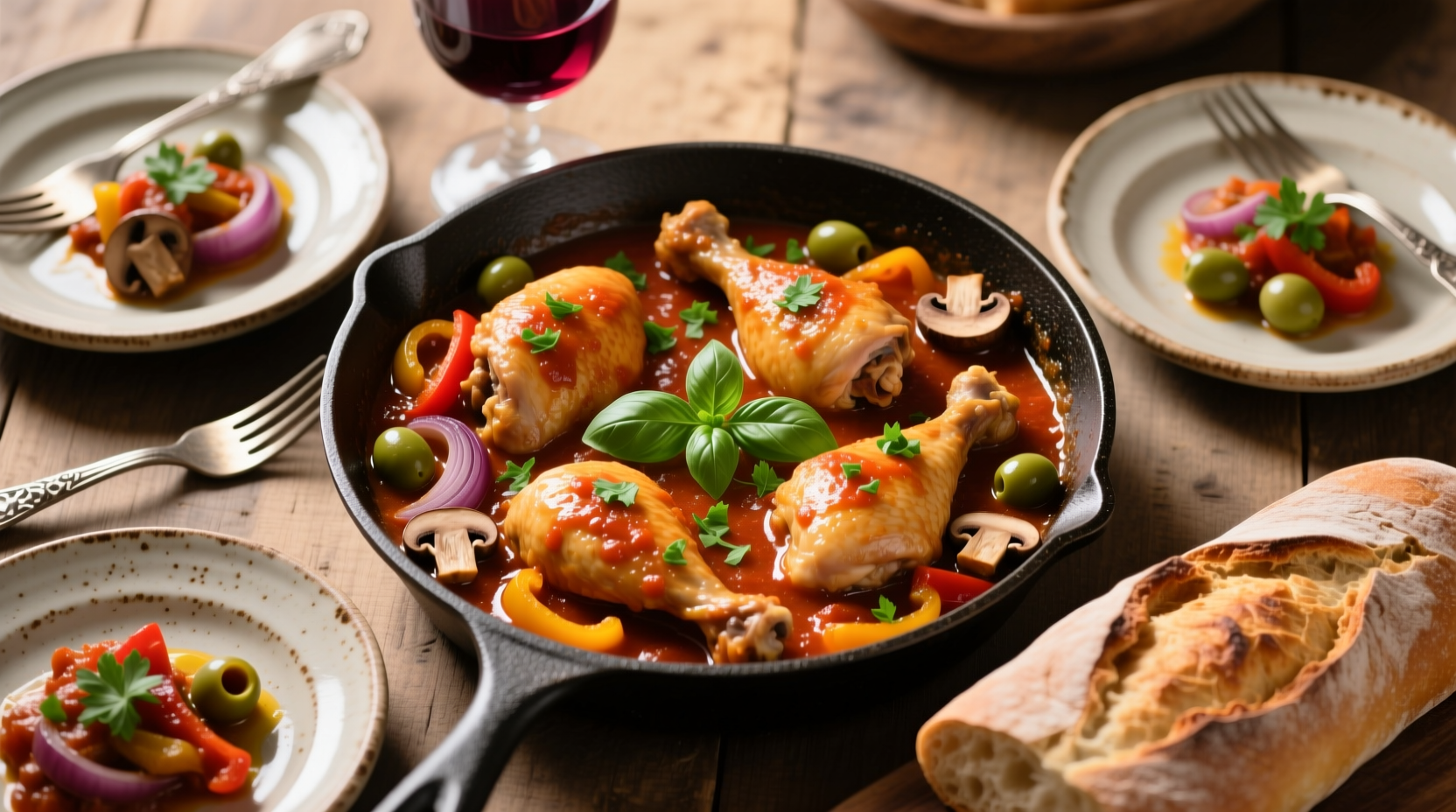When you hear the name cacciatore, you can almost smell the rustic kitchen it comes from. The word itself means “hunter” in Italian, and this dish really does capture that countryside feeling. But don’t be fooled by its humble roots. Chicken Cacciatore is one of those dishes that looks simple on paper but can turn into pure magic when treated with the right care. Today, I’ll walk you through a recipe for four servings, weaving in not just the how but also the why behind each step. This isn’t just cooking—it’s craft.
Why Chicken Cacciatore Still Matters
You’d think with all the modern recipes popping up every second, this dish might lose its shine. But no. Chicken Cacciatore continues to appear in Michelin-level kitchens and home dinner tables alike. Why? Balance. It has the acidity of tomatoes, the depth of wine, the earthy tone of mushrooms, and the robustness of slow-braised chicken.
According to the Italian Culinary Institute, dishes like Cacciatore highlight what Mediterranean cooking does best: layering simple, available ingredients into flavors greater than the sum of their parts. And in a world that often glorifies complexity, this dish proves that restraint wins.
Ingredients That Set the Tone
For 4 servings, here’s what you’ll need. But before the list, let me say this—quality here changes everything. If your chicken is dull, the dish falls flat. If your tomatoes are lifeless, the sauce won’t sing. Don’t compromise here.
- 4 chicken thighs, bone-in, skin-on
- 2 chicken drumsticks
- 2 tablespoons olive oil
- 1 large onion, thinly sliced
- 1 red bell pepper, sliced
- 1 yellow bell pepper, sliced
- 4 cloves garlic, minced
- 1 cup mushrooms, sliced
- 1/2 cup dry red wine
- 1 can (14 oz) crushed tomatoes
- 1/2 cup chicken broth
- 1 teaspoon dried oregano
- 1 teaspoon dried thyme
- 2 bay leaves
- Salt and black pepper to taste
- Fresh parsley for garnish
Notice something? No cheese. No cream. The dish is rich already. Traditional Cacciatore keeps it honest—let the tomato and wine carry the flavor.

Step-by-Step Cooking Process
Step 1: Browning the Chicken
Heat olive oil in a heavy-bottom skillet. Place the chicken pieces skin-side down. Don’t move them around too much. That golden crust, the Maillard reaction, isn’t just for looks—it’s flavor locked into each bite.
Here’s the mistake most home cooks make: crowding the pan. If the chicken steams instead of browns, you’ve lost half the battle. Do two rounds if you must.
Step 2: Building the Base
Once the chicken is golden, remove it and toss in onions and peppers. Let them soften, about 6–7 minutes. Add the garlic and mushrooms. The smell at this point will make you question if you should stop and eat it right there. But patience, patience.
What you’re doing is layering sweetness, sharpness, and umami. These vegetables aren’t just filler; they create the backdrop against which the chicken shines.
Step 3: Deglazing Like You Mean It
Pour in that red wine. Let it bubble and scrape all those browned bits stuck to the pan. That’s concentrated flavor—ignore it, and you’ve wasted gold. About 3–4 minutes is enough.
Some chefs skip the wine, but here’s the truth: without it, the sauce feels shallow. Wine adds acidity, yes, but also complexity. Studies from Food Chemistry journals show alcohol helps dissolve flavor compounds that water or broth alone can’t.
Step 4: The Simmer
Now, add the crushed tomatoes, broth, oregano, thyme, and bay leaves. Bring back the chicken into this bubbling mixture. Reduce heat and let it simmer gently for 40–45 minutes.
This is where time works its quiet magic. The collagen in chicken slowly breaks down, enriching the sauce with body. There’s no shortcut for that.
Step 5: Finishing Touches
Remove the bay leaves, taste the sauce, and adjust salt or pepper. Some like adding a touch of chili flakes here for heat, but that’s optional. Garnish with parsley before serving. The green freshness cuts through the richness beautifully.
Professional Tips and Insights
Chefs often tweak recipes like these to suit their kitchens. Here are some pro insights worth noting.
- Bone-in vs boneless: Always go bone-in for cacciatore. The marrow seeps into the sauce, deepening the flavor. Boneless might cook faster, but it robs the dish of its soul.
- Tomato choice: If you can, go with San Marzano tomatoes. Their balance of sweetness and acidity is unmatched. Cooks Illustrated found in blind tastings that San Marzano consistently outperformed other canned varieties.
- The wine question: Dry red wines like Chianti or Sangiovese are traditional. Never cook with a wine you wouldn’t sip. Cheap wine leaves a bitterness you can’t fix.
- Resting time: Letting the dish sit for 10 minutes before serving actually enhances the flavor blend. Professional kitchens often prepare braised dishes hours in advance for this reason.
Serving Suggestions
Chicken Cacciatore is versatile when it comes to sides. In Northern Italy, it’s often served with polenta. In the South, pasta is common. And in modern kitchens, you’ll find it paired with rustic bread or even couscous.
For this 4-serving recipe, I’d suggest wide pappardelle pasta. The flat noodles grab onto the thick sauce beautifully. Alternatively, creamy polenta creates a comforting, stick-to-your-ribs experience.

Common Misconceptions
Some people think Chicken Cacciatore is just chicken in tomato sauce. Wrong. The heart of this dish lies in the balance of vegetables, herbs, and wine. Remove one, and it collapses.
Another myth is that it must be spicy. While some regions do add chili, it’s not a rule. Italian cooking is deeply regional, and the cacciatore of Tuscany differs from that of Calabria. Respect the roots, then adapt.
Emerging Trends
Interestingly, modern chefs are experimenting with lighter versions. Some replace chicken with rabbit (actually closer to the hunter’s original prey). Others use white wine instead of red, giving a fresher, less intense profile.
Vegan variations are also on the rise, with mushrooms or seitan taking the place of chicken. While not traditional, it shows the adaptability of the cacciatore framework.
Nutritional Insights
A serving of this dish comes in at roughly 400–450 calories depending on the sides. The protein is high, around 30–35 grams per serving. The fat mostly comes from the chicken skin and olive oil, though much of it renders out during cooking.
Tomatoes and peppers bring in vitamin C, while mushrooms add selenium and B vitamins. It’s a dish that nourishes as much as it satisfies. Not bad for a “hunter’s stew.”
A Case Study in Longevity
A 2019 study on Mediterranean diets published in The Lancet highlighted how traditional dishes like Chicken Cacciatore support long-term health. The balance of lean protein, healthy fats, and vegetables aligns perfectly with what nutrition science calls sustainable eating.
That’s one reason why this dish hasn’t disappeared. It’s not just delicious. It’s smart food.
Final Thoughts
Chicken Cacciatore isn’t about showing off knife skills or exotic ingredients. It’s about coaxing brilliance out of the ordinary. If you make this dish for four people, you’re not just feeding them—you’re telling a story.
Remember the essentials: brown the chicken well, respect the wine, don’t rush the simmer. Everything else is style. Serve it with pride, and you’ll see why this “simple” dish has survived centuries without losing relevance.
FAQs
What does Chicken Cacciatore mean?
It means “hunter-style chicken” in Italian, traditionally cooked with tomatoes, wine, and herbs.
Can I use boneless chicken for Chicken Cacciatore?
Yes, but bone-in chicken adds richer flavor and depth to the sauce.
What wine is best for Chicken Cacciatore?
Dry red wines like Chianti, Sangiovese, or Pinot Noir work best.
How long does Chicken Cacciatore take to cook?
About 1 hour total, with 40–45 minutes of gentle simmering.
Can I make Chicken Cacciatore ahead of time?
Yes, it tastes even better when rested or reheated the next day.
What sides go best with Chicken Cacciatore?
Polenta, pasta like pappardelle, or crusty rustic bread pair beautifully.
Is Chicken Cacciatore healthy?
Yes, it’s balanced with lean protein, vegetables, and healthy fats.
Can I substitute red wine with white wine?
Yes, white wine gives a lighter, fresher twist to the dish.
Can Chicken Cacciatore be frozen?
Absolutely, it freezes well for up to 3 months when stored properly.
Do I need mushrooms in Chicken Cacciatore?
They’re optional but add earthy umami that deepens the sauce.

Mariana is a passionate home cook who creates delicious, easy-to-follow recipes for busy people. From energizing breakfasts to satisfying dinners and indulgent desserts, her dishes are designed to fuel both your body and hustle.
When she’s not in the kitchen, she’s exploring new flavors and dreaming up her next recipe to share with the Foodie Hustle community.

